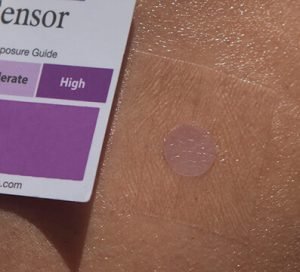
Please note: We can’t stress enough that protecting yourself from excessive UV exposure is a serious issue. Please read these instructions, including the outlined important information, thoroughly. Please also note that sunscreen should be applied 20-30 minutes before intense sun exposure. Sunscreen should be reapplied every two hours in high UV index situations. Always read the label instructions of your sunscreen and carefully follow the advice supplied. Besides sunscreen, where possible, protective clothing, such as a cap and sunglasses, should be worn to protect the ears, face, head and eyes from UV. Seeking shade and staying out of direct sunlight will also greatly reduce UV exposure, particularly around the midday hours when atmospheric UV is at its highest. To learn more about UV and sunscreens read here.
Application of UV Alert Patch
- Apply a UV Alert Patch to clean, dry, sunscreen free skin. Apply the patch to part of the body exposed to the sun (the upper arm is ideal). Face it towards direct sunlight while in the sun. The circular UV sensor in the centre of the patch will turn purple.
- Apply sunscreen over the top of UV Alert Patch at the same application rate you would to the rest of your body. Wait approximately 1 – 2 minutes and the circular UV sensor will turn from purple (exposed to UV) back to clear to pink (protected from UV) under direct sunlight.
- As your sunscreen stops protecting you the circular UV sensor will change colour from clear to pink, more towards purple.
- As the circular UV sensor becomes more purple, reapply sunscreen to stay UV protected.
The colour-changing of the circular UV sensor is affected by the UV index, amount of time spent in the sun, application rate, formulation/actives and the SPF of the sunscreen used, along with the activities done while wearing a UV Alert Patch.
Using the UV Sensor Card for Colour Comparison
Every packet of UV Alert Patches also includes a ‘UV Sensor Card’. A UV test area on the UV Sensor Card changes colour from white to purple when the UV Sensor Card is exposed to sunlight. These colour changes exactly mirror the colour changes that occur on a UV Alert Patch when it is exposed to sunlight. The UV Sensor Card remains unprotected by sunscreen while the UV Alert Patch (worn on the body) is protected by sunscreen. By placing the sunscreen unprotected UV Sensor Card next to a sunscreen protected UV Alert Patch you are able to compare sunscreen protected versus unprotected colour changes. This enables you to better monitor the levels of protection your sunscreen is providing under differing UV Index situations where differing sunscreens (formulation, SPF, broad spectrum rating) are used.
The UV Sensor Card is also very handy for monitoring the environmental UV Index, warning you when atmospheric UV is high.
Important Information
- While a UV Alert Patch will stay firmly attached to your skin for many days we recommend that a patch is worn for no longer than 48 hours on adults and for no longer than 12 hours on children, before removal. Ideally, it is best to remove the patch at the end of the day in the sun and use a new patch when you next require one.
- Multiple studies show that between 50 – 85% of people don’t apply enough sunscreen to protect them adequately from damaging UV. The SPF rating of a sunscreen is determined using a given amount of sunscreen applied per centimetre square of skin. However, studies have determined that most people use about 50% of the sunscreen that is used in SPF testing, reducing the SPF that any given sunscreen offers in real world terms. For example, one study found that typical amounts of SPF 50 sunscreen applied by people provided only a maximum of 40 percent of the expected protection from the sun’s harmful UV rays. The study further determined that protection of the skin from the harmful, UV-induced DNA damage known to underlie cancers was only significant when sunscreen was applied at a thickness between 1.3 and 2.0 milligrams per centimetre square, whereas most people only apply, on average, 0.75 milligrams per centimetre square. [1]. When applying sunscreen correctly you need to use more than you possibly think. A full body application for an adult (dependent on size) should be around 40ml or one fluid ounce in U.S. terms – this equates to about 2 tablespoons or a shot glass full of sunscreen. Read more about sunscreens and UV here
- It is important to note that sunscreen should be applied 20 – 30 minutes before intense/direct sun exposure. For this reason, we recommend that if you are wanting to test the colour change in the UV Alert Patch (when placing sunscreen over it in direct sunlight) this should be done by applying sunscreen to the rest of your body 20-30 minutes before going into direct sunlight, while leaving the UV Alert Patch without sunscreen over it. Go outdoors into direct sunlight and look at the colour change (the disc at the centre of the UV Alert Patch will turn purple). Immediately place the same levels of sunscreen over the UV Alert Patch and any surrounding area left unprotected by sunscreen while in direct sunlight. The circular UV sensor on the patch at this point will change colour from purple to clear or pink (dependent on the sunscreen used and UV index).
- Apply the same levels/rates of sunscreen to the UV Alert Patch as you would to the rest of your body during outdoor sun exposure. Applying a higher or lower rate of sunscreen to the UV Alert Patch than is applied elsewhere on your body, will result in higher or lower UV protection factor (SPF) readings, than is occurring on your skin. It is, therefore, important that the sunscreen application rate to the patch matches how much sunscreen (mg/cm2) you apply to the rest of your body.
- UV Alert Patches (and any other UV colour changing photochromic product) are not suitable for use with non-nano zinc oxide and/or titanium dioxide sunscreens which leave a thick white (or another colour) coating over the UV photochromic disc, rendering it unseeable (and therefore you cannot see it change colour).
- UV photochromic sunscreen monitoring products (including UV Alert Patches) work best with high SPF (SPF 50) chemical filter sunscreens in high UV index situations. Because the UV photochromic pigment is very sensitive to UV, lower SPF value sunscreens (SPF 15 and some SPF 30 products) often allow too much UV to pass through the sunscreen resulting in photochromic spot colour changes which can be hard to read as moderate, high or excessive. Because there are many different sunscreen products on the market, which consist of different formulations/actives, results can be variable with lower SPF value sunscreens, particularly in higher UV index situations.
- The UV Alert Patch adhesive layer sticks strongly to anything it is applied to including body hair. For this reason, it is best not to apply a patch to areas of the body with thick body hair. This can make the UV Alert Patch uncomfortable to remove.
Reference
[1] Young AR, Greenaway J, Harrison GI, Lawrence KP, Sarkany R, Douki T, Boyer F, Josse G, Questel E, Monteil C, Rossi AB. Sub-optimal Application of a High SPF Sunscreen Prevents Epidermal DNA Damage in Vivo. Acta Derm Venereol. 2018 Oct 10;98(9):880-887. doi: 10.2340/00015555-2992. PMID: 29944164.

